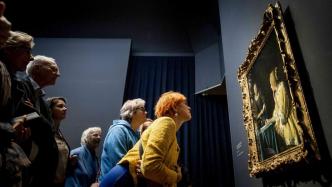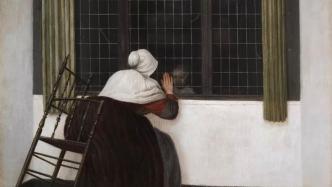

It's an exciting exhibition, just as the characters of the 20th-century French novelist Proust can die in front of Vermeer's "Delft View". Proust also fainted from the excitement of seeing Vermeer's works. So, if there is a chance to see a gathering of most of Vermeer's masterpieces, it is not just an exhibition, but a miracle.
The Paper learned that from February 10, the Rijksmuseum in Amsterdam will launch the "Vermeer" exhibition. Vermeer was an outstanding Dutch painting master in the 17th century. There are only 34 paintings attributed to him so far, and 28 of them will be displayed in this exhibition. These include "Young Woman Sitting Before a Virginal" at the National Gallery in London, "The Lacemaker" at the Louvre in Paris, "The Milkmaid" at the Rijksmuseum in Amsterdam, "Small Street", "Love Letter" and Mauritshuis in The Hague. The Royal Museum of Art has Vermeer's most famous work "Girl with a Pearl Earring".
The curator called the exhibition a “once-in-a-lifetime opportunity,” and he was not exaggerating when it comes to a Vermeer exhibition, as never before has such a large collection of Vermeer’s works been assembled in one place, and it is almost impossible to gather again in the future.

Vermeer, Girl with a Pearl Earring, Mauritshuis

The exhibited works, from left to right are "Woman Reading a Letter by the Window", "Girl with a Pearl Earring" and "The Milkmaid".
Vermeer's works are the most important clues about the mysterious "Vermeer of Delft". He was born in 1632, and he painted at home most of the time and rarely traveled. He left behind nothing but paintings: no letters, no sketches, no diaries, not even a portrait. He died in obscurity in 1675. His works were not recognized during his lifetime, probably because Protestantism was prevalent in the Netherlands at that time, but Vermeer converted to Catholicism after getting married at the age of 21.

Vermeer, "Letter Writer" National Gallery of Art, Washington
Vermeer and the man in the painting face similar lives in the same small town
"Vermeer created approximately 45 to 50 works in his lifetime, and his entire career lasted no more than 20 years. We have identified 37 of them (including works that may be Vermeer, and currently 34 are confirmed to be attributed to him), This exhibition brings together 28 pieces, which sounds incredible," said Taco Dibbits, director of the Rijksmuseum in Amsterdam, the Netherlands.
The 28 works of Vermeer on display come from the collections of seven national museums and private collectors, including almost all the intimate and bright domestic scenes - the maid pours milk, the girl sews lace, the girl at the piano - These are what Vermeer is best known for.

Vermeer, Lacemaker, Louvre, Paris
Looking at Vermeer's work is like diving into a clear blue lagoon of lemon-yellow fish and glistening pearls. Eighty percent of the works are gathered in the exhibition of the Rijksmuseum in Amsterdam, which is enough to surround the audience in the brilliant original work.
The initial germination of the exhibition came when the curatorial team realized that the Frick Collection in New York (Frick Collection) would close in 2023 for renovation. The Frick Collection has not granted three Vermeers on loan for more than a century. After that, after "a lot of hard work", only nine works did not make it to Amsterdam. One of them is "The Concert", which was stolen from the Boston Museum in 1990 and is still missing. Two items from the collection of the Metropolitan Museum of Art in New York cannot be borrowed due to restrictions on terms. Borrow. The remaining 5 pieces were too fragile to make the trip.

Vermeer, Mistress and Maid, Frick Collection, New York
Works on loan include "Young Woman Sitting Before the Virginal" from the National Gallery of London, "The Lacemaker" from the Louvre in Paris, "Woman Writing a Letter" from the National Gallery of Dublin, Ireland, and "Day Lace" from the National Museum of Berlin. "Girl with a Pearl Necklace", in addition to works from Europe, there are also works from New York, Washington, Tokyo.

Vermeer, "Woman with a Pearl Necklace", 1663-1665, Berlin State Museum

Vermeer, View of Delft, 1660-1661, Mauritshuis, The Hague; Vermeer depicts his hometown.
In addition, the "Milk Pouring Maid", "Small Street", "Love Letter", "Woman in Blue Reading a Letter" collected by the Rijksmuseum in Amsterdam, and Vermeer's most famous work "Girl with a Pearl Earring" collected by the Mauritshuis Royal Museum in The Hague. " are included in the exhibition.
These works (most of them completed between 1655 and 1670) are so fragile that they are the treasures of the museum in themselves and are rarely loaned out. Vermeer is like a camera, observing the world with the lens language he learned from the pioneers of science. In a past preoccupied with imaginings of the modern camera, Vermeer holds a special place because he created the greatest photographs with his eye and brush. More than that, in his "Lace Maiden", the person in the painting is fusing gorgeous fiery red and pearly white silk threads, and her eyes never move away from her meticulous work.

Vermeer, The Milkmaid, Rijksmuseum, Amsterdam
The way he saw women freed the imagination: they were so autonomous that Vermeer seemed to know their innermost thoughts, whether they were working women or musicians. Four hundred years later, the audience can't help but complete the story captured by Vermeer in their minds: what did the officer say to the smiling girl, what news did the maid bring to the mistress?
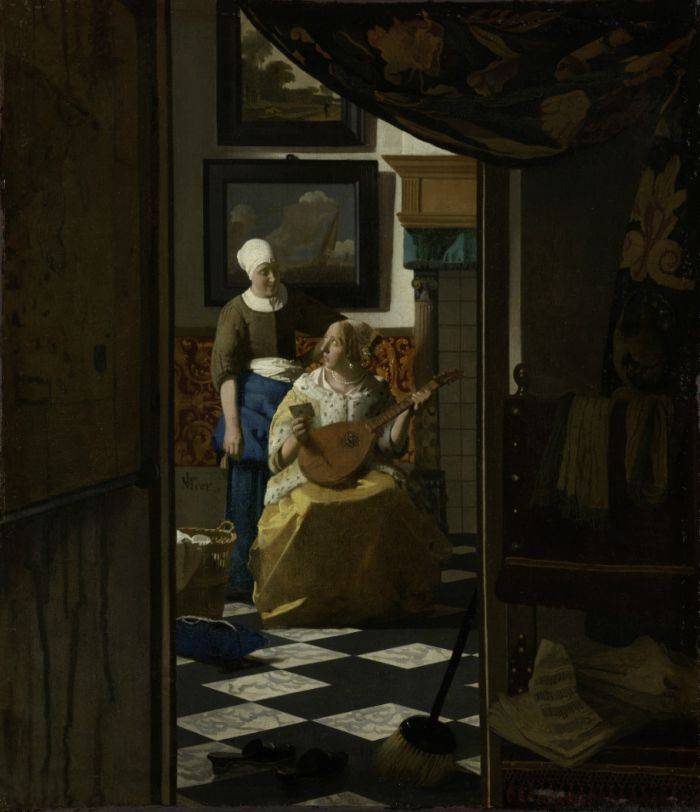
Vermeer, Love Letters, Rijksmuseum, Amsterdam
"He makes people feel that you are there, with the person in the painting, and in that room, time has stopped. And time is stopped, which is what people desire today." Tucker Dibitz said.
The exhibition was not without controversy. In recent years, the Rijksmuseum said three works had been questioned by experts as to whether they should be attributed to Vermeer after a scientific comparative study. The National Gallery of Art in Washington also announced in October last year that "Girl with the Flute" may have come from Vermeer's collaborators.
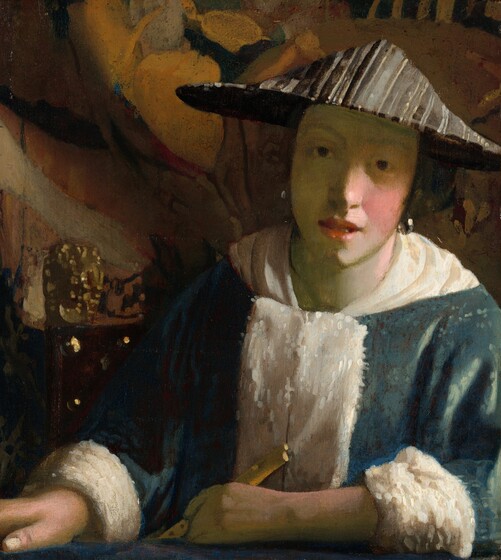
The Girl with the Flute (c. 1665-1675) in the National Gallery of Art in Washington has been removed from Vermeer's possession.
Judging the differences in Vermeer's work is not easy. "Rembrandt has more than 300 paintings to compare, while Vermeer has only more than 30. And different researchers can come to different conclusions even in the same thread. Attribution is not a hard science." Duby "Recent research has shown that beneath Vermeer's meticulous detail lies broad, powerful brushstrokes, contrary to past perceptions of how he worked," said Z.
Through the works, it can be seen that Vermeer painstakingly decorated the interior space in the work just like "The Lacemaker", and he concentrated his own existence in more than 30 paintings. These paintings are connected to form a world - his subjects are in the same small city, in similar rooms, facing similar dilemmas.
The relationships, reflections and vibrations between Vermeer's paintings will be the focus of this exhibition. This is one connection the modern world has with Vermeer.

Vermeer, The Little Street (House in Delft), circa 1658, Rijksmuseum, Amsterdam
Research on Vermeer fever and Vermeer's works
When mentioning the Vermeer exhibition, many people first think of Vermeer's large-scale retrospective exhibition held in the National Gallery of Art in Washington, USA and the Mauritshuis Royal Museum in The Hague, Netherlands from 1995 to 1996. Vermeer's popularity has changed dramatically since then.
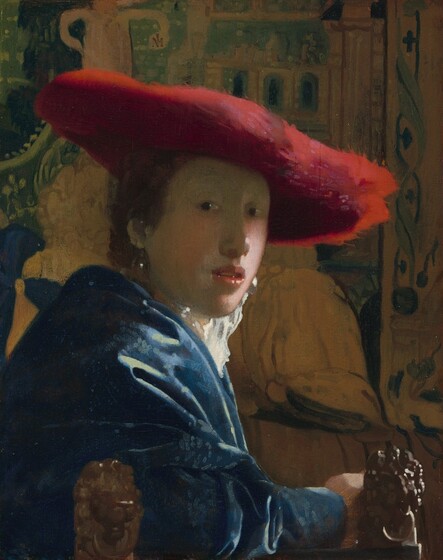
Vermeer, Girl with a Red Hat, circa 1666-1667, National Gallery of Art, Washington
That show was the first-ever "Vermeer solo show"—bringing together 21 paintings and revealing many new insights, but since then there have been only small, incremental discoveries.
Due to Vermeer's almost blank biography, writers, film directors, etc. can satisfy the world's growing demand for understanding Vermeer through creative interpretation. But a large part of the artist's extraordinary appreciation is due to the imagination. Some novels and films embellish Vermeer's life with personal accounts, while other writings attempt to unravel the mysteries of his working methods.
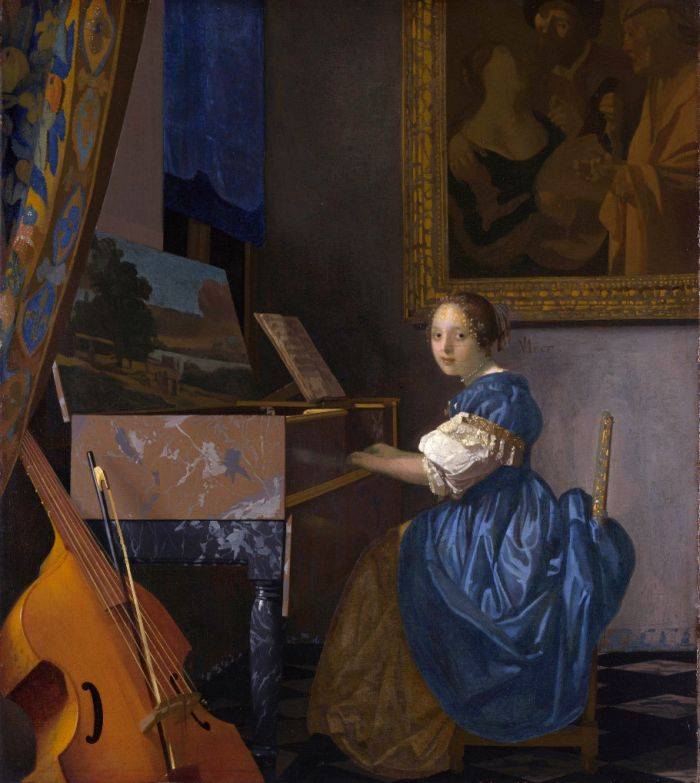
Vermeer, Lady Seated at the Virginal, National Gallery, London
"Everyone can fill in what they can't see," said Martine Gosselink, director of the Mauritshuis in The Hague, which owns works including "Girl with a Pearl Earring" in Three works of Vermeer. “In Vermeer, something seems to be going on, but you’re not sure what,” she added. “It’s the subconscious filling in the missing pieces.”
Erwin Olaf, a Dutch contemporary artist who drew inspiration from Vermeer's work, said Vermeer's paintings evoked associations because of the simplicity of the scene. His photographs, such as "Portrait #5" of a young woman in a yellow dress, can be seen as modern interpretations of Vermeer's quiet minimalism. In 2019, ten photographs by Olaf were exhibited at the Rijksmuseum in Amsterdam alongside paintings by the Dutch Old Masters, highlighting the connection between the two works. "Vermeer wasn't creating portraits, he was creating a staged world. He was telling the story of one or two people - someone reading a letter, someone staring out a window, someone holding a milk jug. It's this simplicity It creates an opportunity for the viewer to create a story in their own head," says Olaf.

Olaf's "Portrait #5" is regarded as a modern interpretation of the tranquility of Vermeer's minimalism. (not this exhibit)
That was the case with author Tracy Chevalier, who began writing a novel about "Girl with a Pearl Earring" in the late 1990s. Her goal for the novel was that "it would be short, with one point of view, as concise and focused as a Vermeer painting."
Because there is no mountain of historical research, Chevalier does not need to learn about Vermeer from old papers. Her greatest inspiration came from the inventory of Vermeer's Delft estate, compiled a few months after his death. These included his wife's yellow-and-black corset in the closet, a jacket trimmed with mink; and a broken pot. This list helps her imagine Vermeer's world.
The best-selling 1999 novel, Girl with a Pearl Earring, is a fictional story about Vermeer and his housemaid, Griet, who served as Vermeer's model and became his muse. The 2003 film adaptation of the same name made Girl with a Pearl Earring a household name and drew pilgrims to the Mauritshuis. "This film makes people who don't know Vermeer suddenly familiar with him, and it also brings us the distant 17th century." Dibitz said.

Stills from the movie "Girl with a Pearl Earring"
Soon, "Girl with a Pearl Earring" became one of the most copied images in the world, appearing on coffee mugs and pillowcases and the basis for thousands of memes.
While some authors sought to fill in the voids of Vermeer's personal life, others sought to demystify his painting process. They seem to think that if we don't know exactly who he is, we can at least understand how he works.
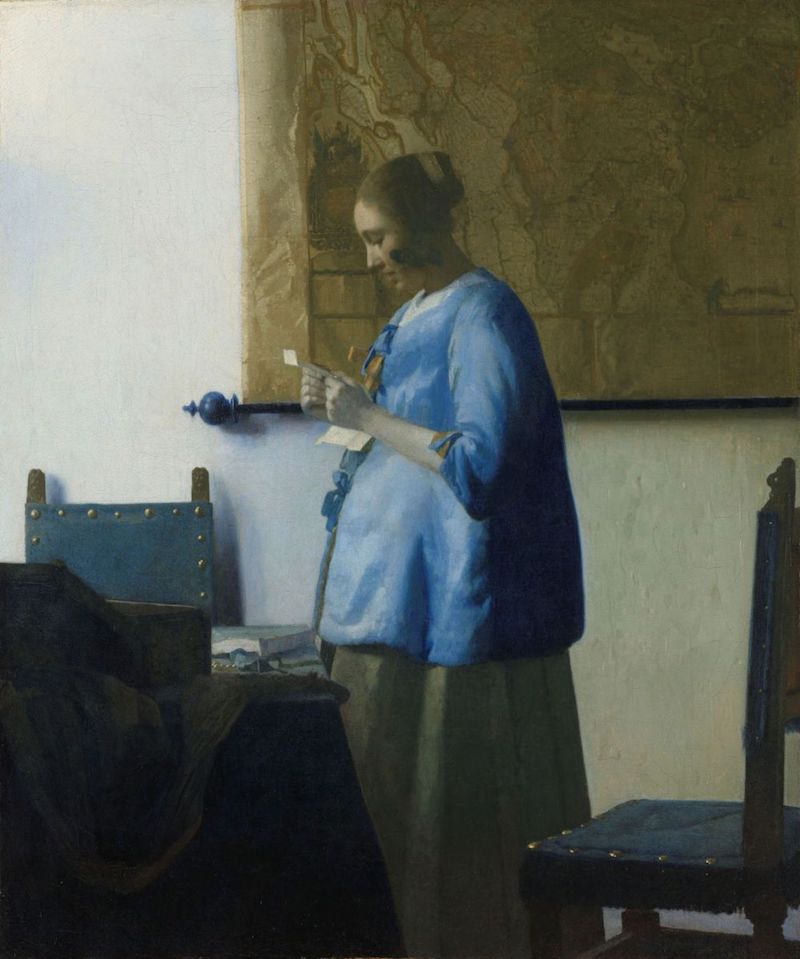
Vermeer, "Woman in Blue Reading a Letter", 1662-1663, Rijksmuseum, Amsterdam
In his 2002 book, Vermeer's Camera, architect Philip Steadman attributed the "perfection" of Vermeer's paintings to the use of optical tools. In particular, he revived an idea first proposed in the 1920s, in which Vermeer painted inside a room-sized camera obscura that worked like a pinhole camera.
Artist David Hockney, who developed the concept further in his 2006 book and the 2011 BBC TV show Secret Knowledge, credits Vermeer's 'photographic' effects with in optical technology. The Steadman and Hockney theory was tested in the 2013 documentary "Tim's Vermeer." In this documentary, inventor Tim Jenison recreates "Music Lesson" using a camera obscura in a Texas warehouse, giving a more authentic version of Vermeer today.
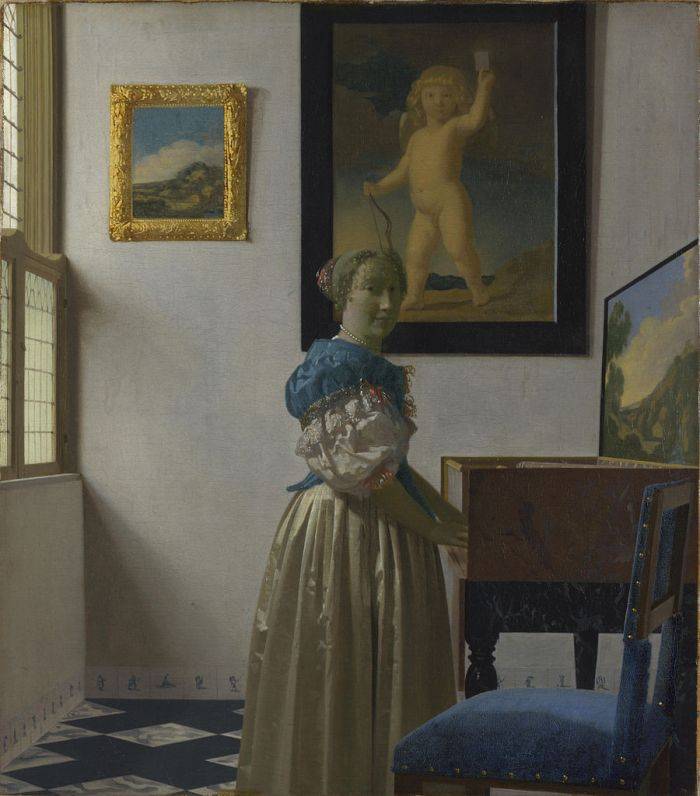
Vermeer, Woman Standing Before Virgina, National Gallery, London
The question of whether Vermeer used optics is one of the main research focuses of this blockbuster exhibition. Gregor Weber, curator of the exhibition and author of the exhibition catalogue, Johannes Vermeer: Faith, Light and Reflection, said he had come to the conclusion that Vermeer likely passed through Delft. Of the Jesuits who had access to optical tools, they owned these instruments and mentioned them in religious texts.
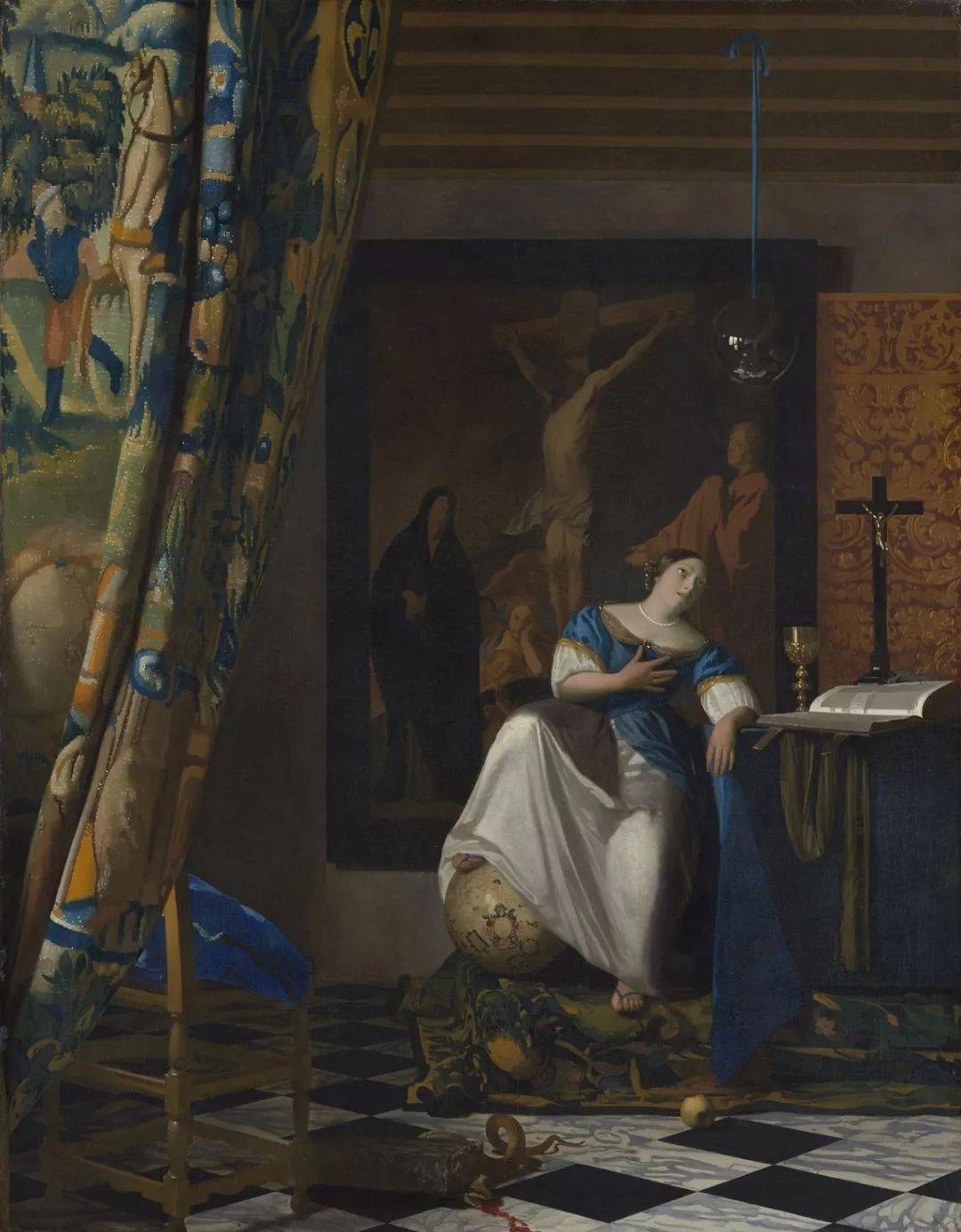
Vermeer, Allegory of Faith, 1670-1672, Metropolitan Museum of Art, New York
One of the effects of the camera obscura is to focus light on one point while obscuring the rest; it is in Vermeer's numerous serene interiors that incorporate a similar effect that this is clear evidence of the Jesuit's connection to art.
Vermeer may have entered the camera obscura and "transferred that experience into his own art," Weber said. In other words, he did not bring optical equipment into the studio, but as a source of inspiration for how light and perspective were depicted in his paintings.
In the absence of sufficient evidence, some museum experts say the best place to look for clues about Vermeer's creative process is in the paint layers of his works.
Scientific advances in the study of painting have helped researchers understand many details of Vermeer's artistic process, says art historian Arthur K. Wheelock Jr., who curated the Vermeer exhibitions in Washington and The Hague in the 1990s "We've learned a lot about painting and pigments since 1995, and there's still a lot of new research in the field," said Dr.
While the findings likely won't change our understanding of Vermeer, according to Wheelock, "help refine our understanding of his compositions and materials, and how his materials age over time."
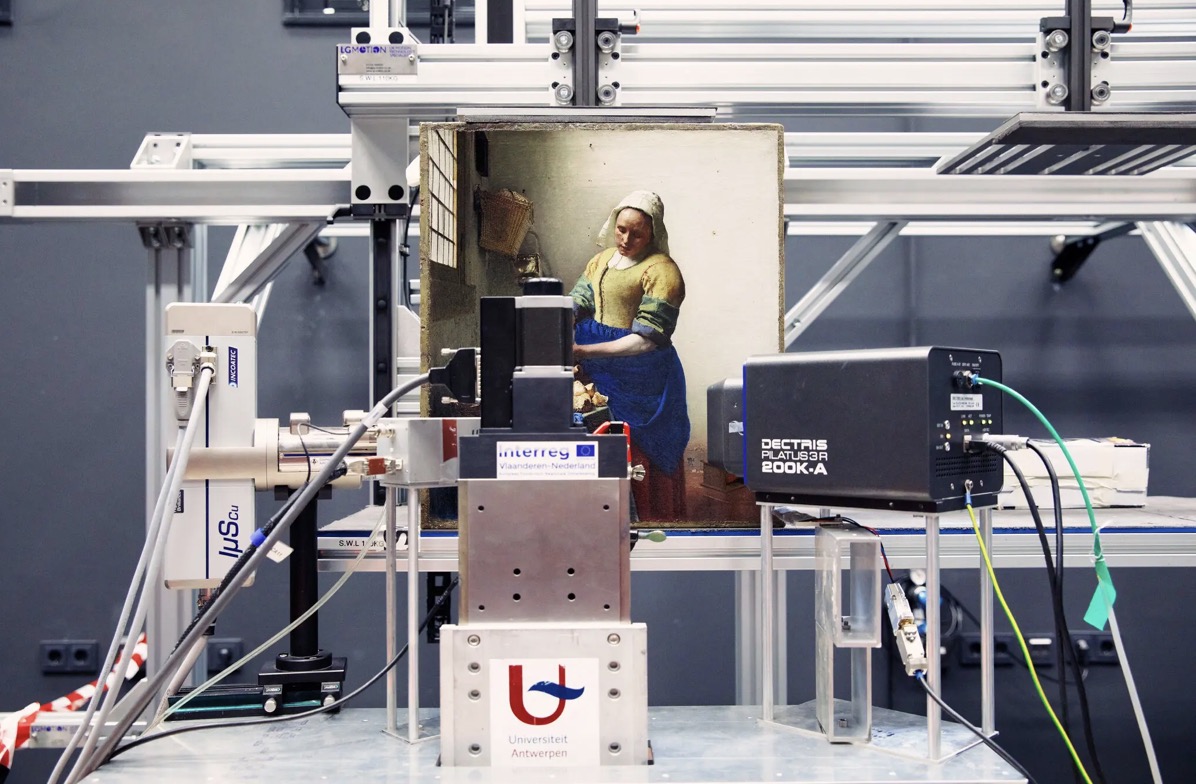
In 2020, the Rijksmuseum in Amsterdam, the Netherlands, conducted a pigment analysis of the collection "The Milkmaid", and non-intrusive scanning technology helped us understand how Vermeer worked.
Recent non-invasive scanning techniques such as infrared imaging show that "Girl with a Pearl Earring" was originally painted with eyelashes, which are now mostly gone; and she was not originally in an empty space, there was once a green curtain behind her , but over time the pigment undergoes chemical changes and it also disappears.
Abbie Vandivere, painting conservator at the Mauritshuis in The Hague, has been working on the restoration of Girl with a Pearl Earring for several years. She says museums will soon be able to recreate Vermeer's working methods through digital simulations. For example, a video demonstration showing how an artist "builds" a painting, from ground floor to surface, and what it might look like "as finished on the easel", and how the work changes over time.
While technology does bring us closer to Vermeer in some respects, Wheelock cautions, “When you look at 17th-century work from a 21st-century perspective, you have to be aware of its limitations.”
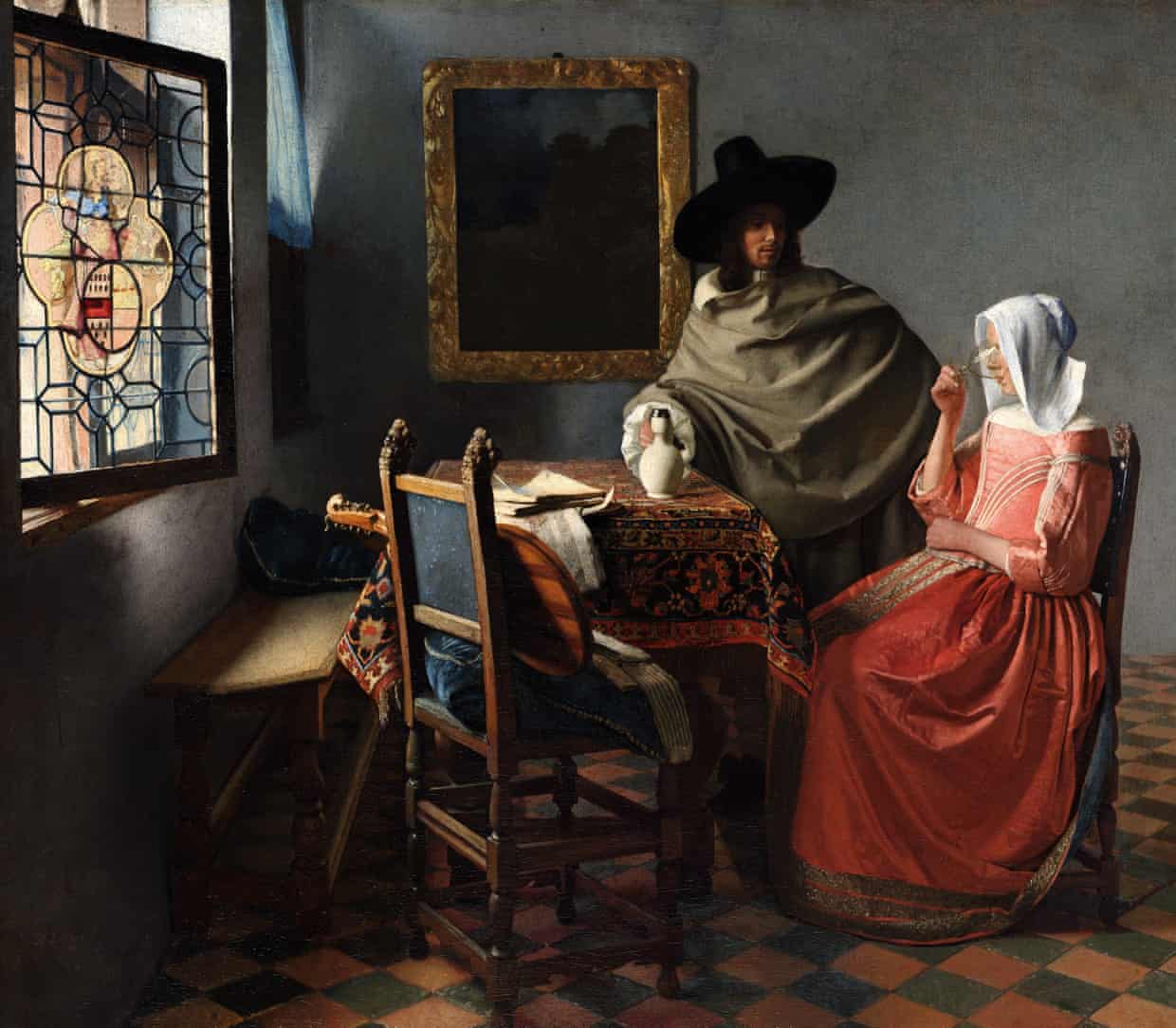
Vermeer, A Glass of Wine, 1659-1661, Berlin State Museum
For now, the best way to understand Vermeer's 400-year unsolved mysteries may be by looking at the works on the walls. Use your own imagination to fill in the blanks. "Whenever you stand in front of Vermeer's paintings, you will be attracted by his world." Dibitz said, "You may want to reconstruct and understand that space, but in fact, we cannot deconstruct and retain this illusion."
The exhibition will last until June 4, 2023. This article is compiled from The Guardian, the website of the Rijksmuseum, etc.
